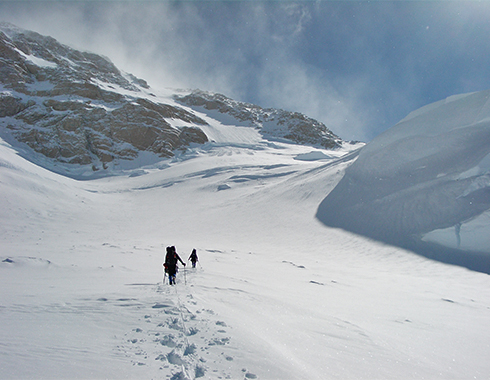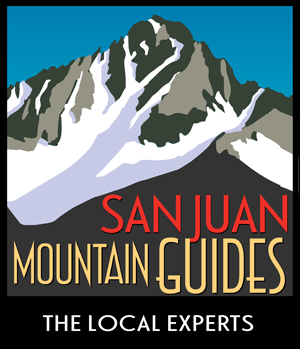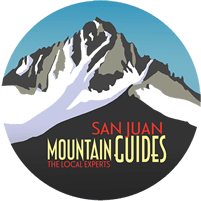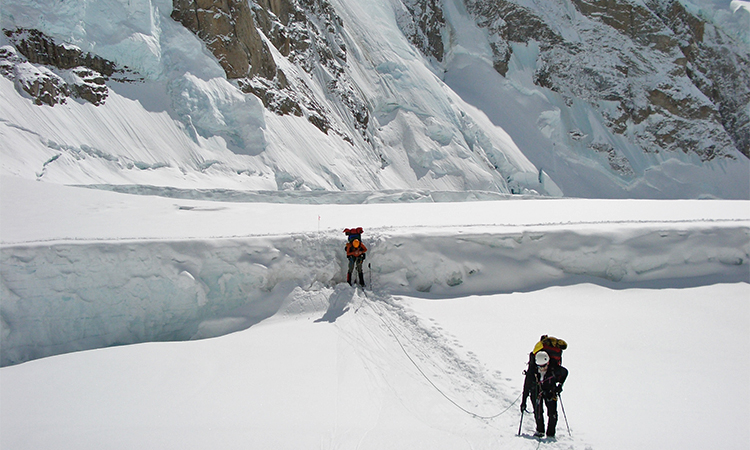The West Rib: A Climbers Route
An aesthetic line sweeping up alongside the massive South Face of Denali, the West Rib is a challenging route for climbers with good technical experience, wishing to push themselves on what definitely qualifies as a “Big Route”. Steeper, more exposed, more committing, and more serious than its neighbor, the West Buttress, the Rib is all about the climbing. Complex glacier travel is required to access the base of the route, which quickly rears back to provide 50 -60 degree snow and ice climbing up the famed “Chicken Couloir” which affords access to the ridge and the rest of the climbing challenges ahead.
Since its first ascent in 1959, the West Rib has continued to provide beautiful alpine climbing in a spectacular setting. Its rich history and moderately technical terrain still attracts the best climbers as they hone their skills. The West Rib feels more remote than the neighboring West Buttress, which in combination with the inherent technical challenges gives the route its mystique and allure for climber’s looking for a different way up North America’s most sought after summit.
Alpine or Expedition Style?
There are generally two ways to attempt the Rib. One is to hike out of base camp will all your kit and climb the route expedition style, ferrying loads between camps, while you acclimatize on the route. Another style involves ascending the West Buttress route to gain acclimatization and to perhaps put a cache in at the high camp on the Rib. The team then descends back to the North East Fork of the Kahiltna at about 7,800 feet to access the route and climb it in alpine style. There are pros and cons to each method, and conditions of the route may ultimately dictate which style we pursue. The outlined itinerary reflects an alpine style attempt.
Permit Note
SJMG runs this trip in cooperation with Mountain Trip, an Authorized Denali Concessionaire.
2023 Dates
TBD
Costs
TBD
No Hidden Fees
Includes:
- Guiding and trip leadership with an AMGA Certified Guides
- Round trip transportation from Anchorage to Talkeetna
- Bush flight to Denali Basecamp with TAT
- 1 night of lodging in Talkeetna
- All mountain food (breakfast, lunch, and dinner in the backcountry)
- Group camping and cooking equipment (tents, stoves, etc.)
- Group climbing and technical equipment (ropes, etc.)

Denali’s West Rib Expedition Itinerary
Itinerary Note
As with all climbs in the Alaska Range, it’s best to approach this expedition with a flexible attitude and be prepared to move camp, climb, and generally get things done when the opportunity presents itself. Weather, route conditions, team dynamics, and a host of other factors can influence how our team decides to adjust the itinerary to give us the best chance for success and safety while on the mountain.
Day 1
Meet in Anchorage. Stay in a hotel.
Day 2
Drive to Talkeetna and check in with the NPS. Fly into Base Camp.
Day 3
Move to Camp 1 at 7800′
Day 4
Carry to 10,000′ and return to sleep at Camp 1 (7800′)
Day 5
Move to Camp 2 at 11,200′
Day 6
Back-carry kit from the cache at 10,000.
Day 7
Carry supplies around Windy Corner at 13,500′. Return to and sleep at camp 2 (11.200′).
Day 8
Move to Camp 3 – Genet Basin – at 14,200′
Day 9
Back-carry from Windy Corner and sleep at Camp 3 (14,200′)
Day 10
Carry supplies to cache at 16,400′ on the West Rib and return to sleep at Camp 3 (14,200′)
Day 11
Descend back to Camp 1 (7800′) and the entrance to the NE Fork of the Kahiltna
Day 12
Move up the NE Fork of the Kahiltna to the base of the Chicken Couloir.
Day 13
Fix lines up the Chicken Couloir. Then return to camp at 11,000′.
Day 14
Ascend the Chicken Couloir and to Ice Dome Camp (13,400′). We’ll climb the entire 1,200′ couloir, using a mix of fixed lines, belayed pitches and simul-climbing. This is the “real deal,” with steep ice and snow, exposure and a dramatic setting for some great climbing!
Days 15 – 16
Continue up the West Rib!
Day 17
Continue up the West Rib to High Camp and our cache at 16,400′
Day 18
Summit day is long, physical, and mentally challenging. The climbing is mostly on show, although we’ll probably climb through a couple of rocky sections as well. The steepest section is the last bit before we top out near the” Football Field,” at about 19,400′. The descent can take as long as the ascent, as we must move deliberately through exposed sections, which can make for somewhat slow going. Plan on 12-20 hours of climbing up and down.
Days 19 – 24
Contingency days for weather, descent, etc.



West Rib Expedition Equipment List
| Duffel Bag | Description | Guide's Pick |
|---|---|---|
 | 1 - 2 Large, durable bags for oragnizing and transporting your gear during airline travel etc. |
| Backpack | Description | Guide's Pick |
|---|---|---|
 | Osprey’s Variant 52 is the ultimate pack for expedition and high alpine climbers. Designed to carry specialized mountain gear such as skis, wands, ice protection, and ice tools, this pack can be easily stripped down to minimize weight for a summit push. |
| Thermos | Description | Guide's Pick |
|---|---|---|
 | Coffee is the lifeblood of champions. We highly encourage the consumption of coffee on our programs. The darker the better. |
| Water Bottles | Description | Guide's Pick |
|---|---|---|
 | We recommend wide mouth Nalgene (or similar) water bottles for the majority of our programs. Two 1 liter bottles is the standard for days in the mountains. |
| Bottle Insulators | Description | Guide's Pick |
|---|---|---|
 | Insulating water bottle parkas are recommended in the winter months, for ice climbing or cold weather alpine trips. |
| Stuff Sacks | Description | Guide's Pick |
|---|---|---|
 | Stuff sacks are a great way to organize your gear in your pack and help to keep things tidy in a variety of ways. A great addition to any of our programs. |
| Personal Food | Description | Guide's Pick |
|---|---|---|
 | Lunch begins when breakfast ends and ends when dinner begins. Bring what you like to eat and consider the length, relative difficulty, weight, and other factors when deciding what to bring in the mountains with you. A variety is always best. Don't be afraid of Mr. T. |
| Sunglasses | Description | Guide's Pick |
|---|---|---|
 | A good pair of wrap around sunglasses are an essential item for all of our trips. When the sun shines brightly on fresh snow in the mountains your eyes will thank you for a quality pair of shades. Looking good is important too. |
| Sunscreen | Description | Guide's Pick |
|---|---|---|
 | Essential for all of our programs. SPF 30 would be our minimum recommendation. Typically a 4 oz. bottle will suffice but consider trip length when deciding how much to pack. |
| Lip Balm | Description | Guide's Pick |
|---|---|---|
 | Lip balm is important to bring on all trips. SPF 15 or higher is recommended. |
| Headlamp | Description | Guide's Pick |
|---|---|---|
 | A headlamp is recommended for all of our programs and is an essential piece of equipment you will use in a variety of circumstances. Most LED type headlamps will do but we recommend the Black Diamond Storm for its versatility. |
| First Aid Kit | Description | Guide's Pick |
|---|---|---|
 | An excellent investment for all of our programs. Our guides always carry a comprehensive medical kit but it's nice to have your own as well. |
| Small Knife | Description | Guide's Pick |
|---|---|---|
 | A small knife is an indispensable tool to carry with you in the mountains. We like the Spatha knife for its size, weight, versatility, and ability to clip onto a harness. |
| Digital Camera | Description | Guide's Pick |
|---|---|---|
 | While phones these days offer excellent quality, nothing beats the reliability of a dedicated digital camera. You'll be glad you brought it and your guide will make sure to help capture the moment of you being awesome. |
| Hand Warmers | Description | Guide's Pick |
|---|---|---|
 | An optional item, but nice to have on cold weather climbs and courses. Consider having a few stowed away in your pack and you can break them out if you feel you need them. |
| Ski Goggles | Description | Guide's Pick |
|---|---|---|
 | From the sweeping peripheral in the Optimum lens, to the horizon-inspired frame structure, FARGO proves sometimes a quick stop in a small place leads to more than you would have ever expected. Goggles are mandatory on all ski programs and cold weather alpine objectives. |
| Socks | Description | Guide's Pick |
|---|---|---|
 | Synthetic socks area must for all outdoor activities. Select a pair that fits well, is warm, and is comfortable. Bring 2-3 pairs depending on the type of trip. |
| Base Layer Top | Description | Guide's Pick |
|---|---|---|
 | Choosing the right base layer really makes a difference in comfort, moisture-wicking, and the balance between cool and warm at the right time and in the right places. The Outdoor Research Echo Hoody also offers good sun protection. |
| Base Layer Bottom | Description | Guide's Pick |
|---|---|---|
 | Similar to the base layer top. These are wear all the time in all conditions base layer pants. A must have for alpine and ice climbing trips and objectives. |
| Mid Weight Top | Description | Guide's Pick |
|---|---|---|
 | A midlayer for anything from ski tours to alpine ascents, the CoEfficient Hoody features Polartec Power Dry High Efficiency fleece with a gridded interior for increased wicking performance and added breathability. The under-the-helmet hood and full-length zipper let you regulate temperature on the go, so you don’t find yourself overheating a half hour into the day. A slim cut helps the CoEfficient Hoody fit comfortably under your shell, and with a redsigned, trim fit, this layer takes up little space in your pack. |
| Soft Shell Jacket | Description | Guide's Pick |
|---|---|---|
 | Designed specifically with Ice and Alpine Climbers in mind, the Outdoor Research Iceline Jacket will foot the bill for your workhorse soft-shell jacket of choice in the mountains. Feature rich and detail oriented, our guides love to work and climb in this jacket. |
| Soft Shell Pants | Description | Guide's Pick |
|---|---|---|
 | The Cirque Pants are a durable, heavy-weight technical soft shell pant built for high-energy climbing, mountaineering and ice climbing. The highly breathable, wind and weather-resistant double-weave stretch fabric excels in high-mountain conditions. The zippered thigh pocket ensures energy bars and maps remain easily accessible. |
| Insulated Parka | Description | Guide's Pick |
|---|---|---|
 | Ice climbers know a thing or two about staying warm in all those long, stationary stretches when their partner is leading a pitch. We made the Perch Belay Parka for them (and for anyone who wants water-resistant warmth while, say, grilling burgers in a ski resort parking lot in February). |
| Insulated Vest | Description | Guide's Pick |
|---|---|---|
 | Same spirit, same guts, and same award-winning hybrid-mapped design of the Cathode Hooded Jacket, minus the sleeves and hood. An insulated vest is an optional item on our programs but we do think vests offer excellent flexible layering options in a variety of circumstances, weather conditions, and trip types. |
| Shell Jacket | Description | Guide's Pick |
|---|---|---|
 | Our Outside Magazine and Men’s Journal “Gear of the Year” award-winning storm shell is engineered for fast-and-light alpine climbs and all-day backcountry tours. You need at minimum either a soft shell jacket or hard shell jacket for local Ouray based winter courses and programs. |
| Shell Pants | Description | Guide's Pick |
|---|---|---|
 | Waterproof, breathable and lightweight, the GORE-TEX® Foray Pants provide dependable rain protection and shrug off the wear-and-tear of the trail and cityscape alike. |
| Warm Hat | Description | Guide's Pick |
|---|---|---|
 | The Booster’s reversible design lets you choose. The soft yarn blend will provide a cozy sanctuary throughout winter’s chill. |
| Baseball Cap | Description | Guide's Pick |
|---|---|---|
 | A required item on the majority of our programs, a baseball cap helps to keep harmful sun off your face. The Radar Pocket cap is packable, durable, and looks great! |
| Lightweight Gloves | Description | Guide's Pick |
|---|---|---|
 | Updated for touchscreen compatibility, the StormTracker Sensor Gloves are equally at home alpine climbing, ski touring or ice climbing. Low-profile GORE® WINDSTOPPER®. Soft Shell fabric deflects biting gusts, and a tricot lining retains valuable heat. |
| Midweight Gloves | Description | Guide's Pick |
|---|---|---|
 | Built to handle cold mornings on the up-track and powder turns all the way back down, these versatile gloves feature a new stretch nylon shell outer, a goat leather palm with textured fingertips, and a warm, quick-drying wool blend lining. |
| Heavy Gloves | Description | Guide's Pick |
|---|---|---|
 | Our pinnacle technical alpine climbing glove was inspired by the design of medieval gauntlets and built for elite climbers. These breathable three-in-one gloves—built with a GORE® WINDSTOPPER® soft shell outer and warm, removable, quick-drying wool blend liners—are perfect for multi-day endeavors. |
| Mountaineering Axe | Description | Guide's Pick |
|---|---|---|
 | A modern version of Chouinard's original curved-pick mountain axe, the Black Diamond Raven Ice Axe is our classic mountaineer's piolet that has been used on classic climbs the world over for decades. The Raven's durable aircraft aluminum shaft and investment-cast stainless steel pick are engineered for secure self-arresting. |
| Belay Device | Description | Guide's Pick |
|---|---|---|
 | A belay device is a required item on any of our technical climbing or mountaineering courses. While not necessary to have the Guide ATC specifically, we think owning one of these offers additional versatility as you progress and gain additional knowledge about the various levels of functionality provided by a device of this type. |
| Harness | Description | Guide's Pick |
|---|---|---|
 | The BD Aspect Harness is a great all around performer for all types of climbing - ice, rock, alpine etc. The adjustable leg loops and integrated ice clipper loops make this a solid investment as your do-all harness. |
| Locking Carabiners | Description | Guide's Pick |
|---|---|---|
 | We recommend at minimum 2 - 3 personal locking carabiners on our climbing courses and any technical private guided program. We prefer classic screw gate carabiners over other types of locking mechanisms. |
| Climbing Helmet | Description | Guide's Pick |
|---|---|---|
 | A versatile, hybrid-shell helmet for lightweight protection in any discipline, the Vector features excellent ventilation and a ratcheting adjuster. |
| Balaclava or Buff | Description | Guide's Pick |
|---|---|---|
 | Simple, effective and infinitely adaptable, Original BUFF® headwear is the product that started the multifunctional headwear revolution. At its core is a moisture-managing microfiber fabric that is wind resistant and able to control odor. We recommend the BUFF for all of our programs as a multi-purpose insulation piece and trendy headgear! |
| Non Locking Carabiners | Description | Guide's Pick |
|---|---|---|
 | A selection of non-locking carabiners is recommended on all of our technical climbing programs. Consider at least 4 - 6 and we prefer wire gate carabiners over more traditional gate carabiners. Many options exist so just consider a variety when putting your carabiner rack together! |
| Climbing Boots | Description | Guide's Pick |
|---|---|---|
 | The Batura 2.0 GTX uses cutting edge proprietary two layer Gore® technology to create a boot that is warmer and more breathable for technical routes in the mountains. An integrated external gaiter with an asymmetrical zipper uses stretch Gore® technology to keep you dry while the inner boot uses another Gore® layer to allow moisture transport to the outer layer creating the ideal climate for your feet in cold conditions. |
| Adjustable Trekking Poles | Description | Guide's Pick |
|---|---|---|
 | This is an optional item on our programs. However, a good pair of trekking poles is a worthy piece of gear to have with you for long approaches or treks through the mountains. There are many added benefits to trekking poles. The new BD Distance series poles are light, collapsible, and adjustable. |
| Cordelletes | Description | Guide's Pick |
|---|---|---|
 | Accessory cord or cordelette material is essential equipment that offer great versatility in use and application. Consider getting a few for your climbing rack. |
| Slings | Description | Guide's Pick |
|---|---|---|
 | Climbing slings or runners are an excellent compliment to your climbing gear. Versatile in their use and applicability, consider having a few of each length on your rack. |
| Avalanche Shovel | Description | Guide's Pick |
|---|---|---|
 | With a redesigned blade construction for cleaner snow study and easier stomping through hard avy debris, the Transfer is our workhorse shovel with a removable, extendable shaft for working in deep pits. |
| Avalanche Probe | Description | Guide's Pick |
|---|---|---|
 | Built for daily snow study, snow professionals and deeper snowpacks, the Tour Probe 320 features a durable, all-aluminum construction. |
| Sleeping Pad | Description | Guide's Pick |
|---|---|---|
 | The Therm-a-Rest NeoAir All Season mattress is lightweight, durable, extremely warm, and the ultimate solution to year-round backcountry comfort. Stable construction and 2.5-inch thickness offer greater comfort for a full night of sleep, so you won't feel the uneven, rough terrain beneath you. |
| Winter Sleeping Bag | Description | Guide's Pick |
|---|---|---|
 | The Western Mountaineering Lynx MF -10 Degree Sleeping Bag is a down sleeping bag for cold weather in the backcountry. Venture into the outdoors in the early spring, on foot or searching for the best ski spots before the snow melts and this medium sized cat will take care of the warmth. Filled with 32oz of 850+ fill power down, you're getting a 9" loft to surround your whole body with warmth as you sleep. |
| Mountain Crampons | Description | Guide's Pick |
|---|---|---|
 | A classic 10-point crampon for mountaineering and glacier travel, the Contact features a durable stainless steel construction and a stable, lightweight design. Available in a Strap or Clip version. |
| Snowshoes | Description | Guide's Pick |
|---|---|---|
 | The MSR Lightning Ascent Snowshoes are lightweight and aggressive to take you onward and upward through all types of terrain. The advanced 360° traction frames provide grippy traction beneath while surrounding a lightweight ballistic decking to keep you up on top instead of postholing your way through the snowfield. The frame and deck combination is super durable and ready to take on all types of snow through changing terrain. |
Training & Follow Up Climbs
As always, being in excellent physical shape is an important component of our our programs. A good mixture of cardiovascular fitness, muscular fitness, and especially core strength will help you to maximize the potential rewards that are possible on a great climbing trip.
Before Your Trip
The Denali West Rib Expedition is a serious undertaking and it is essential that you prepare thoroughly both mentally and physically. In addition, the West Rib Expedition requires a higher level of technical skill so previous steep alpine climbing and/or ice climbing experience is required. Previous completion of our Denali Prep Course, and other high altitude expeditions such as Ecuador’s Volcanoes is suggested prior to enrolling in this expedition. Our Ice Climbing Courses also represent an excellent investment for the technical skills you need to have for this program.
For the Denali West Rib Expedition you should be ready for:
- Backcountry travel and life on an Alaskan glacier
- 18 – 24 days on a glaciated high-altitude mountain
- Cold temperatures, fickle weather, delays, and other factors beyond control
- Carrying a pack loaded with food and gear up to 65 lbs.
Follow Up Climbs
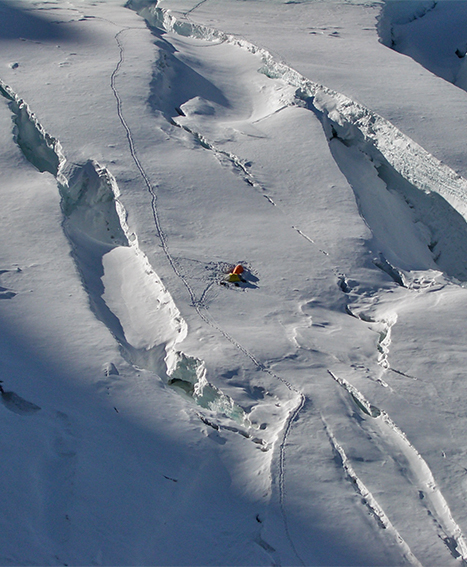
Talkeetna, Alaska: Getting There
Talkeetna, Alaska is the gateway to Denali National Park and the myriad of mountaineering objectives found within. The small historic town swells during the climbing season (April – July) as mountaineers from all backgrounds attempt climbs in the Alaska Range. The town boasts a few good restaurants, hotels, and plenty of small planes!
![]() The best option for flying to the area is to fly into Anchorage, Alaska. We will pick you up at the airport in a rental car, or you may arrange your own transportation to Talkeetna. We will pick you up at the airport or at your hotel and will provide transportation for the remainder of the trip.
The best option for flying to the area is to fly into Anchorage, Alaska. We will pick you up at the airport in a rental car, or you may arrange your own transportation to Talkeetna. We will pick you up at the airport or at your hotel and will provide transportation for the remainder of the trip.
![]() Driving to Alaska is an experience like no other. If you’re into the “full experience” consider driving up to Alaska on the AlCan. It might just turn out to be the highlight of your trip! We will pick you up at the airport or at your hotel and will provide transportation for the remainder of the trip.
Driving to Alaska is an experience like no other. If you’re into the “full experience” consider driving up to Alaska on the AlCan. It might just turn out to be the highlight of your trip! We will pick you up at the airport or at your hotel and will provide transportation for the remainder of the trip.
- Seattle, WA to Anchorage, AK: 34 hours
- Ouray, CO to Anchorage, AK: 48 hours
![]()
If flying into Anchorage early you’ll want to arrange lodging for at least 1 night in Anchorage. Beyond that we’ll be staying in Talkeetna for 1 night. We arrange for lodging in Talkeetna, typically at the Swiss Alaska.
Program Policies
Registration & Cancellation
Advance Registration is required for this program. You have the option to either call our office and register via phone or utilize our secure Online Reservation System. All participants must read and sign an Assumption of Risks/Liability Waiver and agree to our Reservations and Cancellations Policies.
Inclusions
- Guiding and trip leadership with an AMGA Certified Guides
- Round trip transportation from Anchorage to Talkeetna
- 1 night of lodging in Talkeetna
- All mountain food (breakfast, lunch, and dinner in the backcountry)
- Group camping and cooking equipment (tents, stoves, etc.)
- Group climbing and technical equipment (ropes, etc.)
Exclusions
- Transportation to Durango, CO
- Hotel costs before, during, or after the program
- Guide gratuity
- Lunch food or snacks
- Personal hiking/climbing clothing
- Trip Cancellation Insurance (recommended)
- Costs associated with weather delays or other variables beyond the control of San Juan Mountain Guides

Book This Trip!
We Offer Online Registration
- Click on Book This Trip
- Select your Program dates
- Enter your Info and Payment
Or, call 800.642.5389 to register
